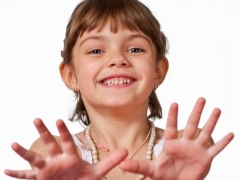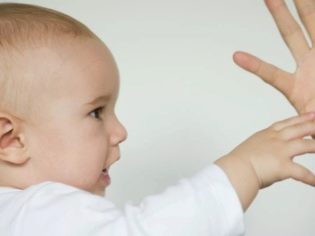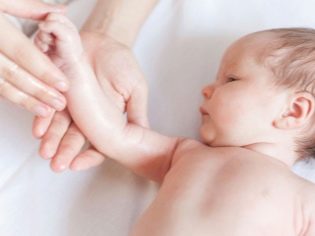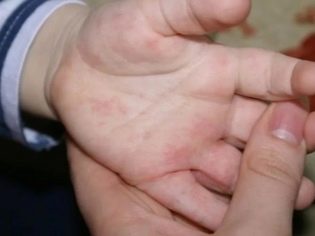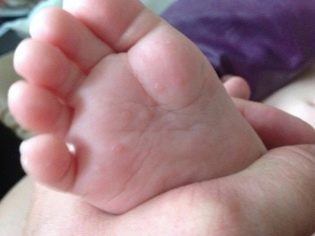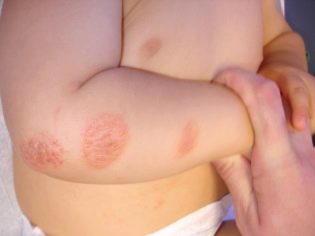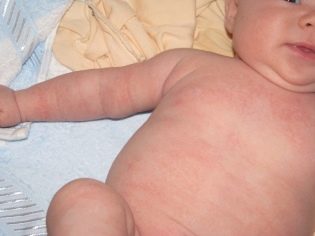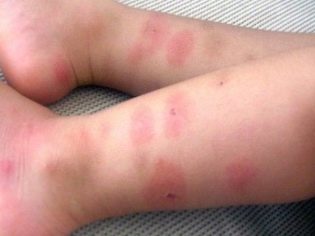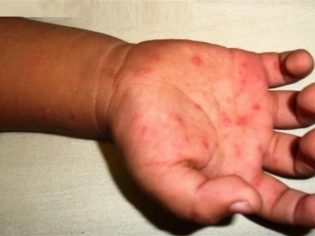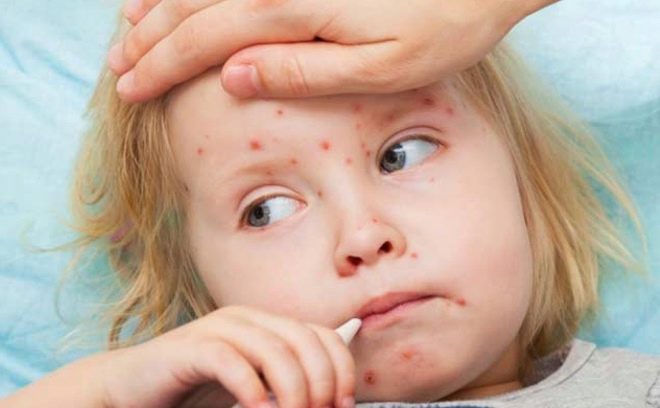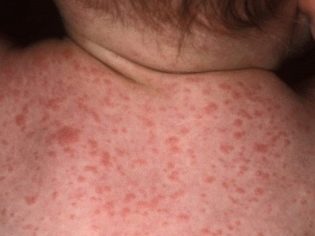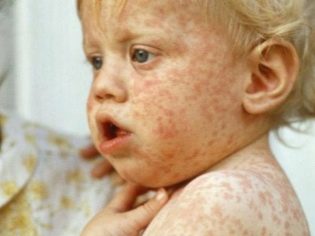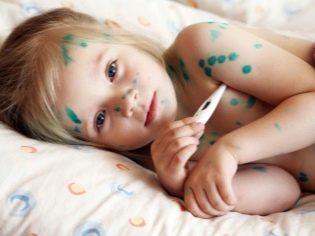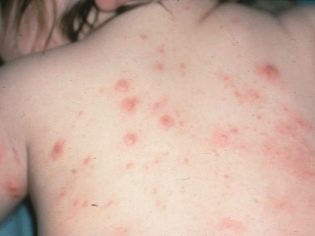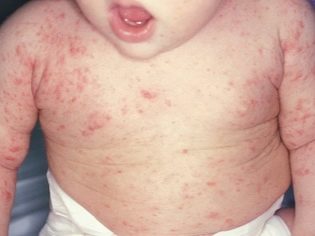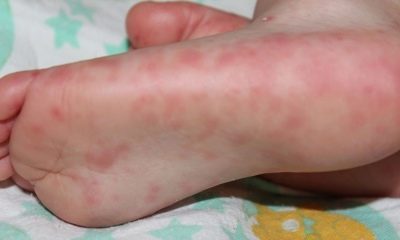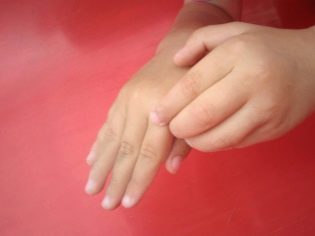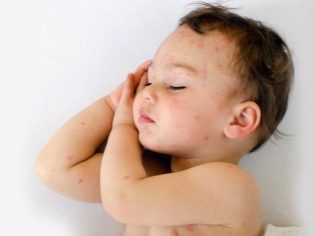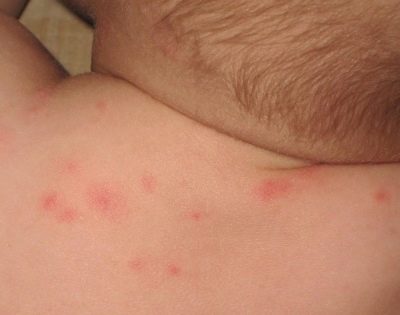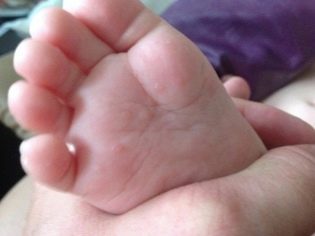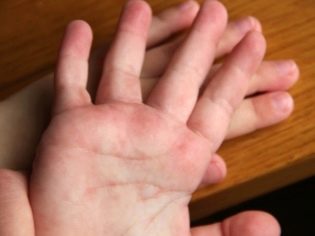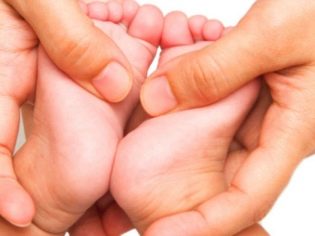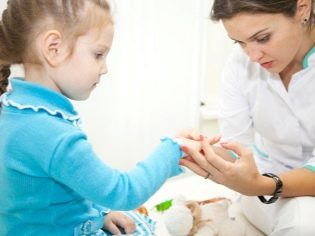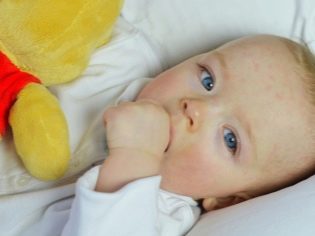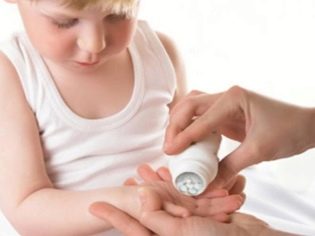Rash on the palms and feet of a child
The appearance of a skin rash on a baby is a rather unpleasant symptom. Rash on the palms and feet can manifest in a child with a variety of diseases.
Causes
A variety of causal factors can lead to the appearance of various rashes on the baby’s skin. The severity of symptoms in this case is usually different and depends on many underlying factors. Thus, the course of the disease in a newborn baby may differ significantly from that of a teenager.
Parents should remember that you should not underestimate the appearance of a child of various rashes. These symptoms can only be the “tip of the iceberg” and indicate the presence of pronounced disorders in the state of the child’s body.
With the appearance of lesions on the skin Parents should seek medical advice. It is impossible to carry out diagnostics at home, as it requires not only conducting a clinical medical examination and examination, but also performing tests.
The most common cause leading to the development of a baby on the palms and feet of eruptions is allergy. This pathology has a huge variety of different clinical options.
Most of them are manifested by the development of eruptions that are located on various parts of the body, including the palms and feet of a child. The development of allergies in the baby can lead a variety of allergens.
In children, quite often the appearance of an allergic reaction on the palms and feet leads use of improperly selected children's cosmetics. Creams or lotions that are applied to the skin of a child can contribute to the appearance of rashes on it.
The development of an allergic reaction in this case also contribute to the chemical components contained in such agents. Rashes on the skin occur predominantly in places of direct contact with the allergen.
According to statistics, allergies to the palms of the palms and feet are more common in children under 4 years of age. This feature is largely due to the tenderness and sensitivity of the skin in children of this age.
In infants, eruptions on the palms and feet are also quite common. In some cases, the rash can spread to other areas of the body. Babies in their first year of life often react to introducing new foods into their diet as first complementary foods.
Infectious diseases can also lead to the development of a child rash on the palms and feet. The appearance of skin rash often leads streptococcal or staphylococcal flora.
These microorganisms actively reproduce on the skin and cause a specific rash to appear on it.
The course of an infectious disease is usually severe and is accompanied by severe intoxication syndrome with the development of fever and fever. Only a pediatrician or pediatric dermatologist can identify an infectious skin pathology after an extended clinical examination of a sick child.
Personal hygiene violation It can also lead to the fact that the skin of a child will have various rashes. Such a rash can appear both on the palms and on the soles of the feet. Quite often, this condition occurs in the smallest children, who still have poor personal hygiene.
The lack of the habit of washing hands after walking on the street and visiting public places, as well as after using the toilet is often the primary cause of the development of various rashes on the skin of a child.
The appearance of loose elements on the skin can lead to banal mosquito bites or other mosquitoes and blackflies. Insects throw a huge amount of substances under the skin that have a biologically active effect. They cause the child a local allergic reaction and inflammation, which are manifested by the appearance of characteristic rashes on the skin. In some cases, such bites are manifested by the appearance of a subcutaneous rash, which is very itchy and brings pronounced discomfort to the baby.
Coxsackie virus infectionIt also contributes to the appearance on the skin of a child of various rashes.
According to statistics, the peak of the incidence of this disease falls on the preschool age. Infants can also get sick.
This pathology is transmitted from an infected person to a healthy one. Every year there are quite a few outbreaks of this viral infection among toddlers attending educational institutions.
The appearance of lesions on the skin is accompanied by a high fever. In most cases, its values can reach 39-40 degrees. Against the background of such febrile, the general well-being of the child is deteriorating. The kid feels pronounced weakness and gets tired very quickly even after performing his usual actions. Severe intoxication syndrome is accompanied by the appearance of lesions on the skin.
With Coxsackie virus infection, skin manifestations occur not only on the arms and legs of the baby. They can also be localized around the mouth or in the area of the mucous membranes of the lips. It should be noted that this infection can also spread by airborne droplets. This causes a rather high incidence in crowded children's groups.
Measles infection It is also a common cause of rash on the baby’s skin. The sick kid feels very bad: his appetite almost completely disappears, the general weakness increases and a headache appears. Body temperature usually rises to 39 degrees. Rashes are localized in almost all parts of the body.
Chickenpox - Another "quarantine" pathology, which causes the appearance of characteristic rashes on the child's skin. According to statistics, the peak of chickenpox disease occurs in the preschool age. This disease usually occurs in younger children much easier than in adolescents and adults. The course of the disease is quite difficult, but the prognosis of this pathology is favorable. After the disappearance of skin rashes on the skin there are no residual changes.
Rubella manifested in babies by the appearance of various skin elements that appear on different parts of the body, including the palms. Any child or adult can become infected with this infection if it does not have vaccinations.
Rubella usually develops rapidly. Skin rash is the most characteristic symptom found in this disease. After infection, the baby remains, as a rule, a persistent life-long immunity.
In the smallest patients, a common cause of the appearance of a rash on the palms is scabies. This disease is caused by scabies mites. These parasites inhabit the surface layers of the skin. Favorite localization for their vital activity is any skin folds. Accompanied by such scabies rash severe itching.
The most rare causes of rash on the palms and feet of babies include various blood diseases. They, as a rule, are manifested by the development of various bruises on the skin, which may be of various sizes.
How does it manifest itself?
Skin rashes may look different. It depends on the reason that caused their appearance.
New rashes have more intensive coloring. Skin elements that have appeared on the skin for a long time, as a rule, become less noticeable. Some rashes are accompanied by severe pruritus, which can disturb the baby both during the day and at night.
Allergy
Allergic rashes on the palms and feet look like bright red specks. These skin formations can be of different sizes. Usually they reach a length of 2-8 mm. Severe allergic reaction is accompanied by the appearance of a large number of different rashes.
Severe itching contributes to the fact that the sick baby begins to comb the damaged skin. This can lead to the formation of secondary bacterial infections in the formed wounds, which causes infection and suppuration.
Chickenpox
Chickenpox is manifested by the appearance on the skin of a baby of various bubbles. Inside is a yellowish liquid. These bubbles may burst with the contents flowing out. In the place of such damaged areas, ulcers are formed, which gradually heal over time. It takes 7-10 days to fully recover from the rash.
Scabies
When scabies on the skin appear numerous red spots. Usually they resemble a small rash. These rashes are very itchy. These skin manifestations are formed in places of entry and exit of scabby mites. Scabies is a contagious disease and moves from a sick person to a healthy one.
Dyshidrosis
In some cases, the baby appears multiple bubbles located on the palms. These rashes are manifestations of dyshidrosis. This pathological condition occurs when excessive sweating and disruption of the sebaceous and sweat glands. This disease manifests itself in the development of multiple lesions, within which there is a watery liquid.
This pathology is more common in the hot season.. In infants dyshidrosis occurs more often. This feature is due to the fact that thermoregulation in babies of this age is still not working effectively enough.
Increased sweating on the feet of a child can also lead to the active growth of fungal flora. In this case, the course of the disease is significantly worsened.
In the initial stage of dyshidrosis, red areas appear on the skin of the palms or the feet, which appear as a tingling sensation. Only a few days later, rashes appear on the skin. In this stage, itching and burning of the damaged skin is also significantly enhanced. Bubbles have a size from 2 to 10 mm.
The duration of rash with dyshidrosis may be different. Usually, the skin manifestations disturb the baby for 10-14 days. Then, with proper local treatment, they completely disappear. Such rashes in the baby can occur again in violation of his general condition. Reduced immunity and severe overheating only contribute to the progression of this condition in a child.
What to do when you appear?
The appearance of any rash on the palms and feet of the baby should be a very important signal for parents. In this case, a mandatory medical consultation is required.
Only an experienced doctor can diagnose correctly. Differential diagnosis of skin rashes is a rather difficult task.
To clarify the diagnosis is required complete blood count. This simple and routine test allows you to establish any functional impairment, as well as determine the severity of the disease.
Many infectious diseases can be identified by a change in the number of leukocytes and a shift in indicators in the leukocyte formula. All bacterial and viral infections are accompanied by increased ESR.
For the treatment of allergic variants of skin diseases, various antihistamines. They can significantly reduce the itching of the skin, and also reduce inflammation.
These drugs can be used as a local treatment. In this case, antihistamine ointments and creams are used. In more severe situations, preformed tablets are used.
To eliminate the adverse symptoms of bacterial infections apply antibiotics. Modern tools have a wide spectrum of action. This treatment is prescribed for 5-14 days.
During antibiotic therapy, the effectiveness of the prescribed therapy is monitored.
To prevent the appearance of rashes on the palms and feet of babies requires the use of hypoallergenic cosmetics. Such products should not contain a large number of aromatic fragrances and aggressive chemicals. It is especially important to carefully choose cosmetic products for babies of infancy and newborns.
About what to do when a rash appears in children, see the next video.
